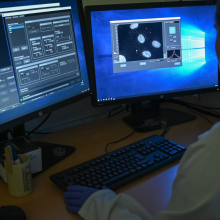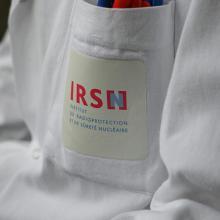Contact
- LEPID : Marie-Odile Bernier
- UEM: Serge DREUIL

The HARMONIC (Health effects of cArdiac fluoRoscopy and MOderN radIotherapy in paediatriCs) project, launched in June 2019 for a period of 5 years, aims to gain understanding of the long-term health effects of medical exposure to ionising radiation in children, specifically those being treated with modern radiotherapy techniques for cancer or X-ray guided interventional catheterization for cardiac interventions.
This project is funded by the European Commission as part of the Euratom H2020 call for projects. It is composed of 24 partners from 13 countries and led by the Spanish ISGLOBAL (Fundacion Privada Instituto de Salud Global Barcelona) institute.
Completion dates : 2019-2024
Budget : 6.9 million euros
Spain : ISGLOBAL - France : IRSN - CEA - INSERM - Centre Régional François Baclesse - Institut Gustave Roussy - Université de Caen Normandie - Germany: Universitaetsklinikum Essen - BIPS GMBH - WPE GGMBH - United Kingdom: UNEW - Belgium: SCK CEN - Katholieke Universiteit Leuven - Sweden: Stockholms Universitet - Denmark: Aarhus Universitetshospital - Aarhus Universitet - Italy: Consiglio Nazionale delle Ricerche - Luxembourg: Luxembourg Institute of Science and Technology - Netherlands: Prinses Maxima Centrum voor Kinderoncologie Bv - Academisch Ziekenhuis Groningen -Norway: Oslo Universitetssykehus HF - Universitetet I Sorost-Norge - Switzerland: Universitat Zurich - Ukraine: NRCRM
The use of ionising radiation for medical diagnosis and treatment procedures has had a major impact on the survival of paediatric patients. Although the benefits of these techniques largely outweigh the risks, there is a need to better understand the long-term health effects of such exposures in order to optimise treatment plans and reduce the risk of long-term side effects.
The HARMONIC project should help to improve understanding of the health effects of exposure to ionising radiation in children in a medical setting, by focusing on two distinct and complementary populations: on the one hand, patients treated with a modern radiotherapy technique (such as proton therapy), and on the other hand, patients treated with interventional cardiology, with doses delivered to the organs varying considerably depending on the complexity of the procedures. This project will shed additional light on the effects of exposure to ionising radiation during childhood and will open up avenues for research on the biological mechanisms underlying secondary cancers and secondary vascular damage.
For the purposes of this research, the HARMONIC project includes two cohorts of child radiotherapy and cardiology patients.
Two of the project's 6 work packages (WP) correspond to the epidemiological study of each cohort. There are two cross-functional work packages, one dedicated to a study of the doses delivered to the organs during the patient treatments (WP4), and the other dedicated to the use of biomarkers and molecular mechanisms to assess the risk of side effects due to exposure of patients to ionising radiation (WP5). The last two WPs concern project coordination (WP1) and the dissemination and communication of the activities of the different axes (WP6).
WP2 aims to assess the health and social side effects of treating children with modern external photon or proton beam radiotherapy techniques (EBRT).
From a health perspective, the study will focus on the incidence and severity, where relevant, of endocrine dysfunction, cardiovascular toxicity, neurovascular damage and secondary cancer. These results will be put into perspective with the distribution of the radiation dose received in the volume of tissues adjacent to the treated area, the radiation administration technique and beam quality factors, as well as varying individual sensitivity to side effects.
This WP will also assess the social impact of the use of EBRTs for children, in particular the quality of life and the consequences for schooling.
People included in the cohort are monitored in hospital and by means of questionnaires. External databases on their morbidity/mortality and the health care provided to them will be set up to allow long-term monitoring. The epidemiological analysis will be supplemented by information on imaging (cardiac ultrasound, neurovascular MRI sequences) and molecular biology (from blood and saliva samples). Demographic, socio-economic, clinical, therapeutic, life-quality, imaging and radiation dosimetry data will be recorded in a centralised database.
This WP will also support data on radiation-induced cell responses and biological mechanisms linked to secondary cancers and vascular pathologies that can develop after radiotherapy. It will also improve individual dosimetry for organs adjacent to the target area for different EBRT techniques.
Finally, it aims to establish standards for optimised individual treatment planning for children in order to reduce the toxicity of treatments.
WP3 is jointly led by IRSN and UNEW and aims to examine the association between exposure to ionising radiation and the risk of cancer in patients who have undergone cardiac catheterization for the purposes of diagnosing and/or treating congenital heart disease.
The cohorts in each participating country are or will be created from records obtained from the main radiology and cardiology departments where paediatric interventional cardiology procedures are performed or from health insurance data. WP3 has established a joint protocol for data collection, dose reconstruction methods (from WP4) and statistical analysis of cancer risks in the international cohort which will consist of data from the various national cohorts.
Biological samples obtained in certain cohorts will allow WP5 (biology) to explore the early molecular mechanisms underlying the association between radiation exposure and cancer risk. Members of the cohort will be monitored using the national cancer and mortality records until 2023 in order to determine the cohort's incidence and mortality due to cancer.
The long-term risk of developing cancer (leukaemia, lymphoma or solid cancer) associated with radiation exposure will be quantified. Estimating the dose-response relationship will require a calculation of the radiation doses absorbed by the organs concerned (doses calculated by WP4).
In addition, WP3 will assess how certain factors, such as age at the time of exposure or possible factors of predisposition to cancer (Down syndrome, transplantation) can alter the association between exposure to ionising radiation and risk of cancer.
The results of the analyses carried out within the framework of this WP will give better understanding of how to assess the risk of irradiation in children, a demographic group for which data is quite scarce. The results will also help improve radiation protection for patients and provide the medical community with new information on radiation risks in children.
WP4 aims to calculate the radiation doses delivered to the specific organs of each patient in the radiotherapy and interventional cardiology cohorts, and to provide data to WP2 and WP3.
For all radiotherapy patients, the dose received during therapeutic and imaging exposures will be reconstructed. Dose estimates for organs at risk in the treatment target area are available from treatment plans. Out-of-field doses, those received by organs far from the target, will be assessed using an analytical tool specifically developed for this study, taking into account the amount of photons, secondary particles and neutrons.
Exposure due to imagery will be assessed using an existing tool specially adapted for the project. All of these tools will optimise the doses delivered during imaging procedures. The accuracy of the calculated and modelled dose estimates will be assessed using Monte Carlo simulations.
For interventional cardiology, a first part of the study will be carried out using data collected before the hospital installation of PACS (Picture Archiving and Communication System), medical information systems for management and digital storage of radiological images. However, the information available from medical files is limited and only cumulative dose indicators such as surface dose product or fluoroscopy time are generally available. More information will be available in digital format during the second part of the study, corresponding to the deployment of the PACS. This will consist of detailed information about each X-ray exposure during a procedure, for example, resulting in a more precise dosimetry.
A dosimetric reconstruction strategy already validated in studies such as EPI-CT and Euraloc, will combine the collected data, data from the literature and specialist knowledge in an effort to overcome the scarcity of data from the periods preceding the roll-out of PACS. A dosimetric system will be specially developed on the basis of Monte Carlo computational codes and hybrid digital phantoms. Experimental validations of the dosimetric system will be carried out on anthropomorphic phantoms exposed in clinical conditions.
WP4 aims to provide clinicians and physicists with dose assessment tools for epidemiological investigations and to help optimise the doses delivered to paediatric patients during cardiac catheterization procedures. It will help define international benchmarks for this type of intervention.
WP5 aims to study the molecular mechanisms and biomarkers that can be used for molecular epidemiology in order to refine the assessment of the risks caused by radiation to the health of children, and to select the most appropriate therapy or optimal diagnostic method. The study uses blood and saliva samples from the cohorts studied in WP2 and WP3.
Differences between biomarkers will be assessed depending on the irradiation technique, beam quality factors or the type of radiation particle.
WP5 aims to develop a framework for future research in molecular epidemiology and to identify predictive biomarkers for radiation-induced vascular disease and secondary cancer. WP5 will focus on the pathways most studied in the literature for their implication in the development of these diseases, such as oxidative stress, inflammation, telomere shortening or miRNA dysregulation.
WP5 thus aims to:
Laboratories : LEPID - Medical Radiation Protection Expertise Unit

LEPID conducts research into the effects on human health of occupational, medical or environmental exposure to low doses of ionizing radiation. This work is based on the epidemiological monitoring of cohorts and innovative statistical analyses, in collaboration with partners in France and other countries.